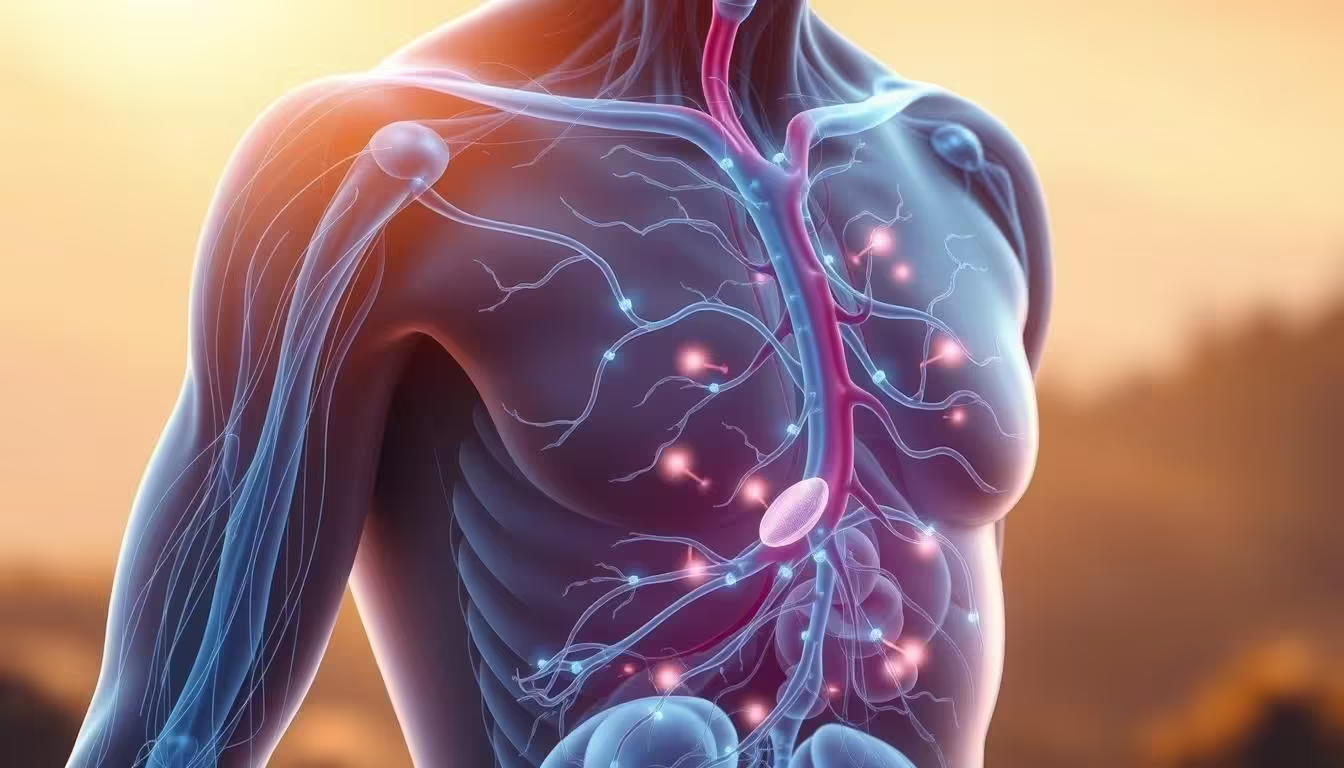The human body has a complex network of tissues and organs known as the lymphatic system, which plays a crucial role in eliminating toxins and waste. This system includes lymph nodes, lymph vessels, the spleen, and the thymus.

Unlike the circulatory system, the lymphatic system relies on muscle movements and breathing to circulate lymph fluid throughout the body. Recent scientific discoveries suggest that during physical activity, this system may generate subtle vibrations that enhance immune function.
These vibrations potentially explain why exercise is linked to improved health and immunity. By boosting the circulation of lymph and immune cells, the lymphatic system actively supports the body’s defense mechanisms.
Key Takeaways
- The lymphatic system generates micro-vibrations during physical activity, enhancing immune function.
- These vibrations represent an evolutionary adaptation that explains the link between exercise and improved immunity.
- The lymphatic system’s active role in immune cell circulation supports overall health.
- This emerging theory bridges biomechanics, immunology, and exercise physiology, potentially leading to breakthroughs in preventative healthcare.
- The connection between exercise and immunity is rooted in the lymphatic system’s function.
The Lymphatic System: Your Body’s Silent Defender
The lymphatic system plays a crucial role in our body’s defense mechanism. It is a complex network that helps defend the body against infection and disease. The lymphatic system’s primary function is to transport lymph, a fluid containing white blood cells, throughout the body.

Structure and Components
The lymphatic system consists of lymphoid organs, lymph nodes, and lymphatic vessels. These components work together to facilitate the circulation of lymph fluid. The lymphatic vessels are crucial for absorbing and filtering out harmful substances from the body.
How it Differs from Blood Circulation
Unlike the circulatory system, which relies on the heart to pump blood, the lymphatic system relies on muscle movement and breathing to circulate lymph. Key differences include:
- The absence of a central pump in the lymphatic system, relying on external forces like muscle contractions.
- The lymphatic circulation operates under low pressure in an open-ended network, contrasting with the high-pressure closed loop of blood circulation.
As Dr.
“The lymphatic system is a vital part of our immune function, and its proper functioning is essential for overall health.”
In summary, the lymphatic system is a vital defense mechanism that relies on movement and muscle contractions to function properly. Understanding its structure and function can provide insights into maintaining overall health.
During exercise, the lymphatic system might produce micro-vibrations
During physical exertion, the lymphatic system may produce micro-vibrations. This phenomenon is believed to enhance immune function by speeding up the circulation of immune cells. The lymphatic system’s role in immunity is crucial, and understanding how exercise influences it can provide insights into the health benefits of physical activity.
Discovery of Lymphatic Micro-Vibrations
Research has led to the discovery that the lymphatic system can generate micro-vibrations during exercise. These vibrations are thought to be a result of the mechanical pressure exerted on lymphatic vessels by muscle contractions. The frequency of these vibrations, typically between 8-15 Hz, is considered optimal for propelling lymph through the vessels without causing damage.
| Exercise Type | Vibration Frequency | Effect on Lymph Flow |
|---|---|---|
| Running | 8-12 Hz | Enhanced lymph flow |
| Swimming | 10-15 Hz | Improved lymph circulation |
| Cycling | 8-12 Hz | Increased lymph propulsion |
How Physical Activity Triggers These Vibrations
Physical activity triggers muscle contractions, which compress lymphatic vessels and stimulate the generation of micro-vibrations. The intensity of the exercise directly correlates with the amplitude of these vibrations, with moderate to vigorous exercise producing the most significant effects. Certain exercise modalities, such as running or swimming, are particularly effective due to their rhythmic, whole-body movements.

The Immune-Boosting Power of Lymphatic Micro-Vibrations
Recent findings suggest that physical activity triggers micro-vibrations in the lymphatic system, boosting immunity. This discovery revolutionizes our understanding of how the body defends against infections.

Accelerated Immune Cell Circulation
The lymphatic system’s micro-vibrations during exercise accelerate the circulation of immune cells throughout the body. This enhanced circulation allows for a more efficient immune response, preparing the body to fight off pathogens more effectively.
The table below summarizes the key benefits of lymphatic micro-vibrations:
| Benefit | Description |
|---|---|
| Enhanced Immune Response | Accelerated circulation of immune cells |
| Active Defense Mechanism | Transition from passive to active lymph flow |
| Improved Health | Boosted immunity through regular exercise |
From Passive Flow to Active Defense
The discovery of lymphatic micro-vibrations marks a shift from viewing the lymphatic drainage as a passive process to recognizing it as an active participant in immune defense. As noted by experts, “This active mechanism appears to be an evolutionary adaptation that maximizes immune efficiency during periods of physical activity.”
“The transition from passive to active flow creates a more dynamic immune response, allowing the body to preemptively increase immune surveillance during physical activity rather than simply reacting to detected threats.”
Understanding this mechanism provides insights into why regular exercise is crucial for maintaining a healthy immune function and overall health.
Scientific Evidence and Ongoing Research
The scientific community is abuzz with the potential discovery of lymphatic micro-vibrations during exercise. As we delve into the intricacies of the lymphatic system, we uncover the complexities of its function and the role it plays in our overall health.
Current Studies on Lymphatic Vibrations
Recent studies have focused on detecting and measuring lymphatic micro-vibrations. Researchers are employing advanced imaging techniques to capture these subtle movements within the lymph vessels. The goal is to understand how these vibrations contribute to the flow of lymph throughout the body.
Challenges in Measuring Micro-Vibrations
Despite the progress, several challenges hinder the accurate measurement of lymphatic micro-vibrations. These include:
- Detecting extremely low amplitude vibrations, often measuring just 10-50 micrometers in displacement.
- Isolating the specific lymphatic signal from other physiological processes.
- Navigating the complexities of human anatomy to reach lymphatic vessels deep within tissues.
To overcome these challenges, researchers must develop innovative methodologies that can provide reliable data while ensuring participant safety. The table below summarizes some of the key challenges and potential solutions:
| Challenge | Potential Solution |
|---|---|
| Low amplitude vibrations | Advanced imaging techniques |
| Signal isolation | Specialized filtering techniques |
| Deep tissue access | Non-invasive imaging methods |

As research continues to advance, we may uncover new insights into the lymphatic system’s role in our overall health and well-being.
Potential Applications in Health and Medicine
The discovery of lymphatic micro-vibrations during exercise opens new avenues for medical applications. As research continues to unravel the mechanisms behind these vibrations, the potential for enhancing lymphatic drainage and overall health becomes increasingly evident.

Implications for Immunotherapy Development
The understanding of how exercise triggers lymphatic micro-vibrations could significantly impact immunotherapy development. By studying how these vibrations accelerate immune cell circulation, scientists can develop more effective treatments that harness the body’s natural rhythms to promote health.
Medical device manufacturers are now developing specialized vibration platforms to optimize lymphatic flow and immune cell circulation, potentially revolutionizing immunotherapy.
Vibration-Based Treatments on the Horizon
Vibration-based treatments are emerging as a promising area in healthcare. Techniques such as whole-body vibration therapy and local vibration therapy are being explored for their ability to enhance lymphatic drainage and promote overall well-being.
Rehabilitation protocols are being redesigned to incorporate specific movements and vibration therapies that stimulate lymphatic micro-vibrations, especially for post-surgical patients. This approach could significantly improve recovery outcomes and reduce complications associated with poor lymphatic drainage.
Conclusion: The Rhythmic Shield Within
Exercise-induced lymphatic micro-vibrations represent a groundbreaking shift in comprehending how physical activity bolsters our immune system. This phenomenon suggests that our bodies amplify defenses through motion, revealing a dynamic immune link. By promoting efficient lymphatic drainage, exercises help in the removal of toxins and waste products from the body, enhancing overall health.
The discovery that our lymphatic system might produce micro-vibrations during exercise has profound implications for understanding immune function throughout the body. It elegantly explains the connection between regular exercise and reduced susceptibility to infections. As research continues, we gain insights into how our bodies have evolved sophisticated systems to maximize defensive capabilities.
This knowledge offers tangible pathways to new therapeutic approaches, benefiting millions with immune dysfunction. It reminds us that our bodies contain self-healing mechanisms activated by natural movement patterns—a powerful argument for regular physical activity.
FAQ
What is the role of the lymphatic system in our body?
The lymphatic system plays a vital role in our body’s defense against infection and disease. It helps to circulate immune cells, remove waste products, and promote overall health.
How does physical activity affect the lymphatic system?
Physical activity stimulates the lymphatic system, promoting the circulation of lymph fluid and immune cells throughout the body. This can help to boost the immune system and improve overall health.
What are lymphatic micro-vibrations, and how are they triggered?
Lymphatic micro-vibrations are subtle vibrations that occur within the lymphatic vessels during physical activity. These vibrations are triggered by muscle movement and help to promote lymphatic drainage.
Can lymphatic micro-vibrations improve immune function?
Research suggests that lymphatic micro-vibrations can help to accelerate immune cell circulation, potentially leading to improved immune function and a reduced risk of illness.
Are there any potential health benefits associated with lymphatic micro-vibrations?
Yes, lymphatic micro-vibrations may have several health benefits, including improved immune function, reduced inflammation, and enhanced overall well-being.
How can I promote lymphatic drainage through physical activity?
Engaging in regular physical activity, such as walking or yoga, can help to stimulate the lymphatic system and promote lymphatic drainage. You can also try techniques like rebounding or lymphatic massage to support lymphatic health.




